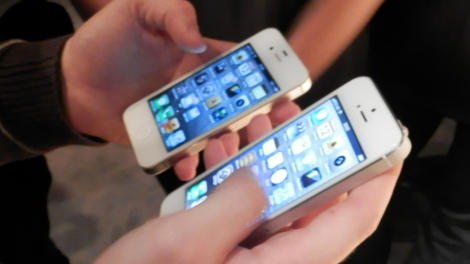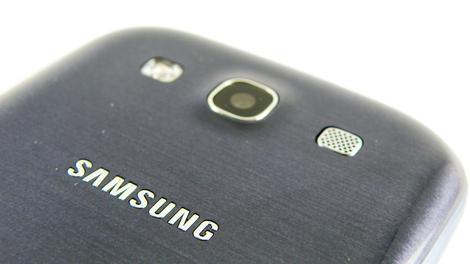| Blip: Revealed: the world's cheapest and most expensive iPhone 5S Nov 22nd 2013, 12:58, by John McCann 
Ever wondered if you're getting a bum deal on your iPhone 5S? Well now you can find out thanks to the iPhone 5S Price Index from Mobile Unlocked. Based on the idea of the Economist's Big Mac index, this version pulls in the cost of the 16GB iPhone 5S from 47 countries around the world, converting the prices to US Dollars (and Pound Sterling) and then offsetting the cost against each country's GDP. What does this all mean? Well in short: if you're in Qatar you'll be laughing, while anyone in India will be weeping into their wallets when they realise the true cost of their beloved iPhone 5S. More blipsWhile you get your head around Jordan's Gross Domestic Product check out more of our affordable blips.        |  | Video: Xbox One smartphone: the ultimate gaming mobile Nov 22nd 2013, 12:38, by Owen Hughes 
Console gaming reached its zenith this month as both the PlayStation 4 and Xbox One moved from stuff of legend to actually, physically sitting under our televisions. Microsoft's next-gen console goes on sale today, hot on the heels of Sony's system which made its show-stopping debut on November 15. It already has some big shoes to fill: the PS4 is Sony's fastest-selling console ever after it shifted over one million machines in the first 24 hours on sale. So what could help Microsoft steal the limelight? We've certainly got a few ideas. With help from our friends at O2 Guru, we imagined what it'd be like if Microsoft took the Xbox One, waved its magic wand and transformed it into a smartphone. The results are enough to have any gamer drooling all over their new AMD-based architecture. Check out the 3D concept render below, and tell us what you think in the comments. YouTube : https://www.youtube.com/watch?v=fDimzvgYczY&feature=c4-overview-vl&list=PLvj1L6okKcaazumThTgGwYy8ZFTtppw2J       |  | Week in Tech: From Windows 1 to Xbox One Nov 22nd 2013, 11:42, by TechRadar 
If this week was a word, that word would be "Microsoft": where last week was all about the PS4, this week is all about the Xbox One and Microsoft's consumer products. Microsoft's console drops today (Friday), and it's more expensive that its Sony rival. Is the Xbox One worth the extra cash? As Alex Roth points out, it's hardly getting off to the most spectacular start: it needs to "overcome the mixed messaging, the now-canned 24-hour online dependence and the other potholes that had it stumbling out of the gate," but "thanks to a strong launch line-up and more than a bit of damage control, the Xbox One is repairing its reputation." Microsoft's ambitions are as massive as the console. The Xbox One is more than a console: it wants to be your home entertainment hub, your social networking hub and your one-stop shop for every conceivable kind of media. Inevitably some of the features are US-only - the cable TV integration won't be available in the UK at launch - and some key apps such as iPlayer aren't ready yet, but as a piece of tech it's certainly impressive. So which should you buy, the Xbox One or the PS4? Matt Swider breaks down each console's key strengths, weaknesses and most important differences, but the smart buying advice might be much simpler: wait. Both consoles are brand new, are bound to encounter teething issues and will become more attractive as more games and apps become available. Closing the app gapApps are arriving on Windows Phone too, albeit slowly: Microsoft says that it'll close the "app gap" between Windows Phone, Android and Apple by the end of 2014. Most of the big-name omissions are now available for the platform (for example Instagram arrived this week) but Microsoft's definitely playing catch-up and its rivals have an enormous head start. How things have changed for Windows. Back in 1985, Windows 1.0 was cutting-edge technology. Screenshots show an entry for a "software shoppe" (which presumably sold things on "ye olde floppeye diskes"), and its promo clip was the first video appearance of a certain Steve Ballmer. Successive versions proved to be quite popular, especially when Windows reached version three. But however many amazing things Microsoft has made, it wasn't cool in 1985 and it isn't any cooler now - and stunts like its horribly unfunny anti-Google mugs don't help. The Keep Calm parody ("Keep Calm While We Steal Your Data") has been widely mocked online, and deservedly so - but are we mocking the messenger instead of paying attention to the message? Gary Marshall thinks so. "If you'd told us a few years back that going online would subject innocent UK citizens to indiscriminate US state surveillance, that faraway firms would track us around the internet and record every conceivable bit of data so they could sell it on, and that TV manufacturers would apparently think it was okay to spy on their customers, we'd have been marching down the high street with flaming torches. Instead, we're mocking Microsoft."        |  | Sony Xperia Z1s release date and price leaks online Nov 22nd 2013, 11:11, by John McCann 
The Sony Xperia Z1s is currently doing the rounds online and now we may have an idea of its price, along with a possible release date and some more snaps of the shrunken smartphone. Sony is expected to follow in the footsteps of the Samsung Galaxy S4 Mini and HTC One Mini with the pared down version of its flagship Xperia Z1 handset. New images popped up on Digi-wo, which has leaked Xperia Z1s information in the past, with one suggesting the phone will cost 3,600 Yuan (around $590, AU$640). However, the pricing detail has obviously just been pasted on top of the image - there's no way to verify this information. Same specs, smaller size?
That said, we're still relatively confident that the Xperia Z1s will see the light of day - Sony has let the handset out of the bag on its own website. Reports surrounding the Sony Xperia Z1s are currently pointing towards the same 2.2GHz quad-core processor, 2GB of RAM, 32GB of storage and huge 20.7MP camera of the Xperia Z1. We'd be surprised if the pint-sized phone really does sport the same features as its big brother, as various concessions are usually made for the smaller form factor and lower price bracket. The latest leak also pegs the Xperia Z1s release date for the first quarter of 2014, so hopefully we won't be waiting too long to find out what Sony has to offer.        |  | Octa-core Odin processor tipped for LG G3 Nov 22nd 2013, 11:01, by John McCann 
Hold on to your hats, folks, tablets and smartphones in 2014 look set to blow us away with supercharged processors and LG is getting into the game. Korean site Digital Times reports that LG is improving the quad- and octa-core versions of its Odin processor, raising speeds for its Cortex A15 cores from 1.7GHz to a meaty 2.2GHz on the main big.LITTE configuration. The second quad-core unit bolted into the octa-core chip is also said to be getting a speed bump, with the Cortex A7 processor now clocked at 1.7GHz - up from 1.2GHz. Eight core phones and tabletsWe've already seen Samsung stick its own octa-core processor into one variant of the Samsung Galaxy S4, and we expect several manufacturers to follow suit with their next generation flagship smartphones. Chinese chip maker MediaTek claims it has the first "ture octa-core" processor, and Qualcomm's recently announced Snapdragon 805 offering means the mobile power competition is really hotting up. LG's new eight core chip is tipped to make its way into the successor of the LG G2 phone (the LG G3, perhaps) as well as the firm's next generation tablet which is set to replace the G Pad 8.3. Meanwhile the quad-core variant is destined for larger LG electronics such as its Smart TVs.        |  | US mulling end to ban on in-flight cell phone calls Nov 22nd 2013, 00:49, by Michelle Fitzsimmons 
Talking on a cell phone mid-flight may soon be permissible. Yes, you read that right. The United States Federal Communications Commission is gearing up to propose letting fliers to use their mobiles to make calls and more on airplanes, according to the Wall Street Journal. Passengers still wouldn't be able to use their phones during take off and landing, but texts, calls and other cellular-data required actions would be A-OK above 10,000 feet. However, even if the FCC does lift it's ban, it would still be up to airlines whether to allow in-flight calls on their planes. It would also fall on carriers to install cell-tower communicating equipment on aircraft, so a new policy would by no means take effect immediately. 'HELLO? NO, I'M FLYING. YES! I'M ON THE PLANE RIGHT NOW!'Last month, the US Federal Aviation Administration loosened restrictions on using electronics during flight, and most concerns about using gadgets while soaring high above have faded. However, the social consideration of passengers blathering away on cell phones while dozens are literally trapped listening to them is one airlines, workers and consumers are already talking about. Flight attendants, for example, have raised concerns that having to compete with a mid-convo passenger during an emergency situation poses a safety threat. Delta, Southwest and Virgin have said that even if the ban is lifted, in-flight phone calls stand a snowball's chance in hell of happening. "[The] overwhelming sentiment is to continue with a policy that would not allow voice communications while in flight," Delta told the Journal. Other airlines have said they would re-examine their policies if the FCC makes the ban a thing of the past. It could be months before the FCC makes a final decision, so until then, it's airplane mode only.        |  | iPhone 6 with 4.9" screen reportedly roaming the testing grounds Nov 21st 2013, 23:24, by Michelle Fitzsimmons 
One of the biggest bits of speculation around the iPhone 6 is that it will feature a larger screen, and now word has surfaced Apple is actively testing such a spec'd phone. According to a tip to C Technology (Google translation), Apple is putting a phone prototype with a 4.9-inch screen through the paces. There's nothing else to the report, and we recommend taking it with shots of salt, but the tip falls neatly in line with other iPhone 6 screen size rumors. Reports have Apple working on next-gen phones with 4.7- and 5.5-inch displays, and last month we heard a 5-inch screen would land on a new iPhone in September 2014. Clearly nothing is confirmed, but with all the smoke that's rising, it seems highly likely Apple is at least toying with the idea of bumping up its display size with the iPhone 5S' follow-up. iPhone 5C to see a dispaly boost too?Surprise! The screen stuff doesn't stop there. According to the same site, the iPhone 5C will also see its display enlarged at its next upgrade. It's unknown just how much the iPhone 5C 2's display will grow, but if the tip proves true, it would come in higher than the current version's four inches.        |  | Updated: With additional damages settled, Apple vs Samsung turns back to devices Nov 21st 2013, 22:50, by Michelle Fitzsimmons 
Not every chapter in the galactic patent battle between Apple and Samsung is destined to be a page-turner, and such was the case with the recent partial retrial to decide how much extra in damages Sammy owes Cupertino. The 8-member jury came back with a figure today, saying Samsung must pay Apple $290 million (about £179.4m, AU$314m) in addition to what it already owes, bringing the total figure to more than $900 million (about £556.8m, AU$973.1m). The amount is close to what Apple sought in the retrial. The company was after damages related to 13 Samsung phones and tablets that another jury determined last year violated patents covering the iPhone and iPad. As reported by the San Jose Mercury News, the retrial jury broke down damages by device; the Infuse 4G cost Samsung nearly $100 million (about £61.9m, AU$108m), while the Droid Charge racked up $60 million (about £37.1m, AU$65m). Not bad for 2-year-old phones. Device timesSamsung, which said additional damages shouldn't be more than $52 million (about £32.1m, AU$56.4m), will appeal this ruling. But until that process gets off the ground, we have the next segment in the frenemy saga to look forward to. In March, both will be back in court for yet another argument over patents. Unlike the 2012 trial, 2014's will tackle whether current Samsung products, such as the Galaxy S3, violate Apple's IP. Additionally, earlier this week Apple scored another chance to ban some Samsung phones and tablets from being sold in the US. A federal appeals court found that presiding Judge Lucy Koh made some errors in denying Apple's request to ban 26 Samsung products, and has ordered a re-examination of evidence. This leaves the door open for an injunction and could impact devices in the 2014 trial. Update: Both Apple and Samsung have responded to the verdict. "For Apple, this case has always been about more than patents and money," the company said in a statement to AllThingsD. "It has been about innovation and the hard work that goes into inventing products that people love. While it's impossible to put a price tag on those values, we are grateful to the jury for showing Samsung that copying has a cost." For its part, Samsung confirmed it will appeal the decision: "We are disappointed by today's decision, which is based in large part on a patent that the U.S. Patent and Trademark Office has recently deemed invalid. While we move forward with our post-trial motions and appeals, we will continue to innovate with groundbreaking technologies and great products that are loved by our many customers all around the world." - Take a break from all the legal talk and take a bit out of our hands on PS4 review.
       |  | 64-bit Android tablets are coming next year, says Intel CEO Nov 21st 2013, 22:21, by klee 
For now Apple's new iPad Air and its other A7-processor equipped devices are sitting pretty as 64-bit mobile devices, but Intel says that's all going to change next year. The chipmaker revealed as much during an investor meeting this week, where CEO Brian Krzanich informed attendees that the company is developing a 64-bit version of the Android. The plan is to release tablets running the OS following Bay Trail tablets running 64-bit versions of Microsoft's Windows 8.1. The Windows 8.1 tabs are expected in the first quarter next year. Krzanich went on to say that Android tablets equipped with Bay Trail processors could come with a starting price of $150 (about £92/AU$162). What's more, apparently all Bay Trail chips already support 64-bit addressing, which means a software update could make a whole range of Bay Trail devices 64-bit capable as well. Intel is also currently developing an image of Android 4.4 KitKat. What does 64-bit really mean anyway?For a long while now, most Android mobile devices ran on ARM or Intel processors equipped with 32-bit versions of the OS. Meanwhile, Apple's latest hardware, namely the iPad Air, iPad Mini 2 with Retina display and iPhone 5S, have the A7 processor and 64-bit iOS operating system. Technically speaking Apple isn't the first 64-bit mobile device maker. Microsoft introduced its original Surface Pro tablet running a full version of 64-bit Windows 8 last year. But this is closer to carrying around a full-fledge PC because it packed a real Intel Core i5 processor. Semantics aside, a 64-bit system on mobile devices grants access to greater increased system memory and paves the way for Ultra HD video. Thirty-two-bit systems thus far have always been limited to 4GB of RAM. It probably won't be a big issue for some years to come, especially as the only phone that will reach this memory limit is the rumored Samsung Galaxy S5. Currently 3GB of RAM is the highest we've seen on handset like the Samsung Galaxy Note 3 and LG G2.   |  | Apple's latest Liquidmetal patent filings cover 3D printing Nov 21st 2013, 18:05, by JR Bookwalter 
Apple's Liquidmetal ambitions have been all the rage in recent months, but a handful of new patent filings published this week reveal that Cupertino could implement some form of 3D printing with the technology. Patently Apple today reported on five new Apple patent filings published by the US Patent & Trademark Office, all of which revolve around the company's future plans for implementing the super-strong Liquidmetal alloy. With earlier patent filings suggesting next year's rumored iPhone 6 could utilize bulk metallic glasses (BMG, the technical term for Liquidmetal), Apple's most recent "highly technical" patent filings hint at other possible uses. Published Thursday, the latest round of patents focus on how Liquidmetal might be used to improve devices such as smartphones (i.e., future iPhones), tablets such as the iPad or even TV and computer monitors. A new dimension3D printing comes into play by allowing Apple to use "computer-generated design data" to create enclosures for devices where size and space constraints might make them impossible to be done using other methods. "3D printing can be quicker and less expensive than machining of prototype parts or production of cast or molded parts by conventional 'hard' or 'soft' tooling techniques that can take from a few weeks to several months, depending on the complexity of the part," the report noted. One such patent filed in May, 2013 titled "Layer-by-Layer Construction with Bulk Metallic Glasses" describes how BMG could be applied in layers and even intermixed with layers made of non-BMG material. Liquidmetal would allow Apple to construct parts for such devices using a layer of BMG powder capable of being fused to other layers through laser or electron beam heating to arrive at the desired shape(s).        |  |
No comments:
Post a Comment